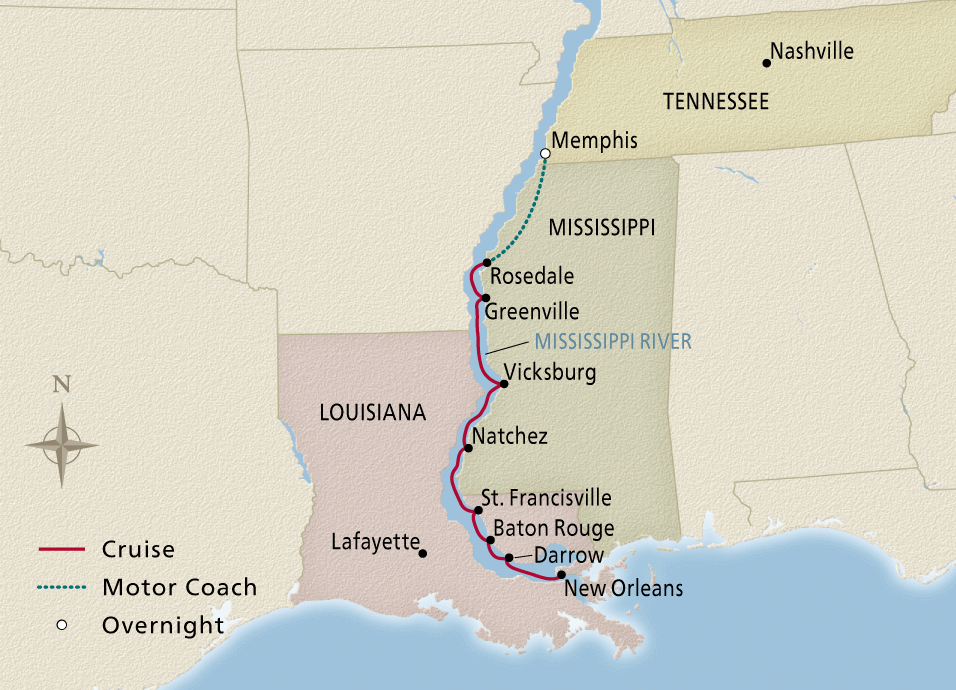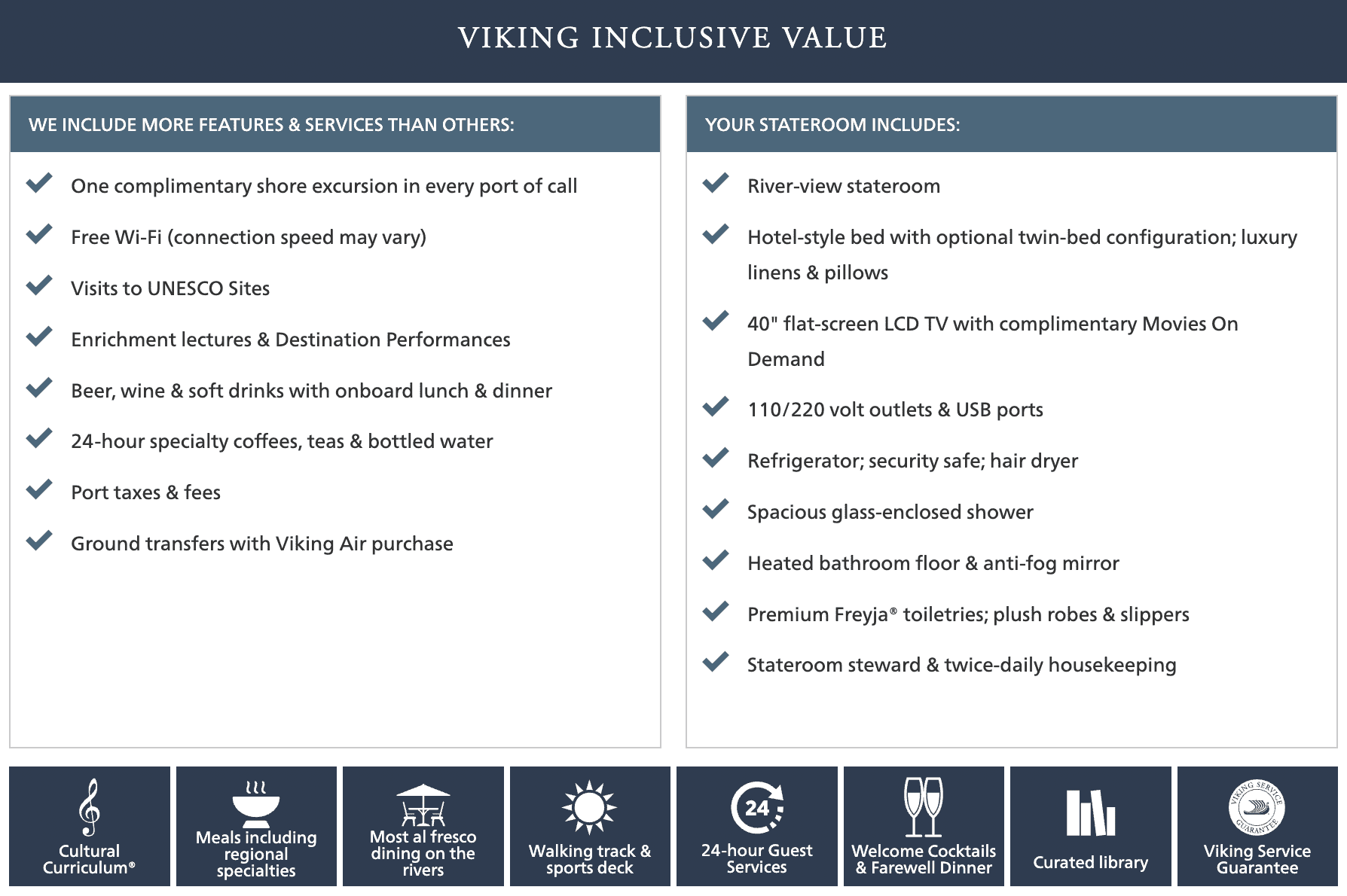Call us or email us if you have any questions.

Discover Southern culture and charm
Immerse yourself in history and heritage on this journey bookended by New Orleans and Memphis. Attend a Privileged Access Mississippi Delta blues experience in Greenville and be inspired by the stories of famed musicians and iconic civil rights heroes. Savor delicious Cajun and Creole cuisine, as well as Memphis’s famous barbecue. And stir your soul with the rhythms of Dixieland jazz, Delta blues and gospel.

New Orleans, United States / Memphis, United States
2023 Sailings from November to December
2024 Sailings from February to June, and on November
* Please check with us for dates & pricing
Cruise fare from $6,099.0 per person
* Please check with us for dates & pricing

Arrive and check in to your hotel. The birthplace of American jazz, New Orleans exudes a festive atmosphere along the balcony-lined Bourbon Street. Here, in the heart of the French Quarter, soulful rhythms lift the spirit, especially during the city’s Mardi Gras celebration. Founded by French colonists in 1718, New Orleans served as a territorial capital before the Louisiana Purchase of 1803. Its distinctive St. Louis Cathedral—named for King Louis IX of France—is the oldest cathedral in the country. The city’s French, African and other influences flavor its vibrant culture and tantalizing Creole cuisine.
Often referred to as “The Big Easy,” the city of New Orleans radiates charm and is renowned for its Southern hospitality. Steeped in a proud musical tradition, some of the finest jazz and blues musicians can be seen performing each night at the many historic venues found throughout the city. New Orleans is also home to the oldest continuously operating streetcar line in the world, and its four classic lines offer a convenient way to explore the city’s historic homes, parks and museums, which include the New Orleans Museum of Art and the National WWII Museum.
The celebrated cuisine of New Orleans is a melting pot of culinary traditions, combining African, Native American, European and Cajun influences. Its hearty dishes are renowned for their bold flavors and creative use of spices and seafood. Regional favorites include gumbo, a thick stew made with okra, seafood and sausage; and the po’boy, a sandwich filled with fried seafood or meat. The city is also famous for its spicy Creole fare, which features mouthwatering dishes such as shrimp Creole, crawfish étouffée and jambalaya, a rice dish with sausage, chicken and seafood. Transfer to your ship and settle into your stateroom.
The Lower Mississippi region is dotted with historic mansions; Darrow is the gateway to these grand homes, meticulously kept to preserve the memory of early Southern American history. Here, imposing houses share the riverscape with moss-draped oak trees and farm fields. It is easy to imagine steamboats and other vessels delivering supplies and materials to these stately front doors. Today, several properties are designated National Historic Landmarks for their architecture, their landscaping, and the contributions of those who maintained the houses and the lands.
The capital of Louisiana, Baton Rouge paints a historic picture on the eastern bank of the Mississippi. Its early success was due to its flood-free location upon the first natural bluff north of The Delta. French explorer Pierre Le Moyne, Sieur d’Iberville, named the city after a red-hued pole that marked the area’s tribal hunting grounds. Its cultural diversity—from its Cajun and Creole music and cuisine to its arts offerings—reflects the European immigrant settlers and the African people brought as enslaved people. The city boasts the tallest capitol building in the United States.
Boasting more than 140 buildings on the National Register of Historic Places, St. Francisville is set along one of the most historic bluffs of the Mississippi. The town is said to be “two miles long and two yards wide” because it was originally built on a narrow ridge overlooking the river. Founded in 1809, it is the oldest town in Louisiana’s Florida Parishes. Remarkably, many of St. Francisville’s structures are not its own; rather, they were moved upriver from Bayou Sara in the 1920s after the small settlement was destroyed by years of flooding.
Natchez has one of the highest concentrations of historic Southern estates in the country. More than 200 perfectly preserved homes line its avenues. It is the oldest city on the Mississippi, established in 1716 by French colonists and named for the Natchez tribe who once called it home. With its ideal locale, the city became a crossroads among Native American and European cultures. Famously, Natchez was the southern terminus of the Natchez Trace, the overland route to Nashville that allowed traders to bypass the strong upriver currents. Today, it evokes small-town America.
Located on a high bluff where the Yazoo River flows into the Mississippi, Vicksburg is the epitome of Southern heritage and charm. It was incorporated in 1825 and, with its prime locale on the Mississippi, grew into an important port. During the Civil War, Abraham Lincoln called it “the key to the South.” And it indeed proved to be the site of the conflict’s most pivotal battle, the Battle of Vicksburg, after which the Confederates surrendered to Ulysses S. Grant. The Vicksburg National Military Park preserves the battle site’s rolling green fields and grand monuments.
Greenville is Mississippi’s largest river port, set atop the highest point along the Mississippi River between Vicksburg and Memphis. Its rural setting belies a diverse artistic heritage. The Muppets creator Jim Henson was born here, and the city has been home to numerous authors, including noted historian Shelby Foote. Greenville is also steeped in the blues; famed songwriter W.C. Handy was inspired to popularize the genre after seeing pioneering musician Prince McCoy perform at a nearby dancehall and neighboring Indianola was the hometown of the legendary B.B. King.
Rosedale is in Bolivar County, where the surrounding Delta region is known as “the land where the blues began.” The town was immortalized in Robert Johnson’s 1937 recording “Traveling Riverside Blues.” The song—as well as the rest of Johnson’s recorded repertoire—had a major influence on rock ’n’ roll; Cream incorporated the mention of Rosedale in their remake of another of Johnson’s classics, “Crossroads.” Today, the town has become associated with the legendary bluesman, and as such, features a commemorative marker in his honor on the historic Mississippi Blues Trail. After breakfast, disembark your ship and transfer to your destination.
Situated on the Chickasaw bluffs overlooking the Mississippi River, Memphis is revered for its blues music and barbecue. Some of the most famed names in blues, including B.B. King, got their start in Memphis, and the city has a well-deserved reputation as the home of this classic American music genre. Memphis is also celebrated for its culinary heritage and is renowned for its traditional barbecue restaurants serving flavorful dry rub ribs. Rich in history and culture, Memphis’s many notable museums include the National Civil Rights Museum and Elvis Presley’s Graceland. Arrive and check in to your hotel.
The “Queen City of the South” is the birthplace of Memphis blues, popular in vaudeville shows of the early 20th century. With its strong trade in agricultural goods and other natural resources, it grew into one of the South’s largest commercial centers. Memphis famously boasts a wealth of civil rights history, much of it along Beale Street and at the Lorraine Motel, site of Dr. Martin Luther King, Jr.’s assassination. It is also the home of Graceland, the mansion where Elvis Presley, “the King of Rock ’n’ Roll,” lived.
Memphis played a pivotal role in the early years of rock ‘n’ roll. During the 1950s, the city was home to several influential record labels, including Sam Phillips’s Sun Records, which released what is arguably the genre’s first song—Ike Turner’s Rocket 88. The label was also home to legendary artists such as Elvis Presley, Johnny Cash and Jerry Lee Lewis. Memphis also had a vibrant club scene, with venues like the Cotton Club and the Palace Theater hosting performances by African American musicians, many of whom had a profound influence on the genre’s nascent development. After breakfast, check out of your hotel and journey home.
* One shore excursion included per port; all others available at an extra charge.